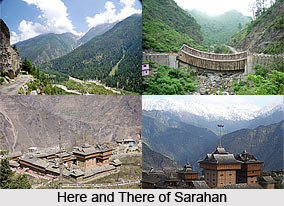 Sarahan is located in the foothills of Himalayan Mountains.
Sarahan is located in the foothills of Himalayan Mountains.
Location of Sarahan
Sarahan is situated in the Sutlej valley. Sarahan was the old capital of Rampur Bushair one of the biggest princely states in Shimla hills. Sarahan is located on the Kinnaur-Shimla border in Himachal Pradesh. It offers natural eye soothing beauty and is a comprehensive place of sacredness. It is a heaven enriched with awe-inspiring qualities.
Climate of Sarahan
The months from March to October are of great amusement in Sarahan. Summer is cool, but daytime temperatures can go up to 32 degree Celsius, while the winter is chilly with snow. Carry both the combination of cotton clothes and heavy woollens for summer and winter respectively.

History of Sarahan
There are several mythological stories that are woven around Sarahan. Centuries ago, the Raja of Kullu District declared war on neighbouring Kingdom Bushair. Post the huge intense and bloody war, the king of Bushair won victory over the opponent. The separated head of the ruler of Kullu was brought to Sarahan and placed on the stone platform. The family members of raja of kullu and the people of his kingdom pleaded to return his head so that they could perform the last funeral rites. The ruler of Bushair laid three conditions before them before he would return the head - the land that was seized across the Sutlej would be retained, Kullu must promise to never again challenge its neighbour and the captured image of Lord Raghunath (the pattern Devta of Kullu) would not be returned. The defeated kingdom accepted all these terms and in return only asked the ruler of Bushair to celebrate the festival of Dussehra. This request was accepted and Dussehra has now become a major local festival. The image of Lord Raghunath was ceremoniously installed alongside that of Bhimakali.
Tourism in Sarahan
 The scenic beauty of Sarahan compiles of breath-taking greenery, waving mountains, snow covered regions. Sarahan`s apple orchards make the dusty environment pleasant with its fragrance. Sarahan is filled with flowering pine trees, huge forests, streams and it`s worth remarkable valleys. God would have been very bighearted while creating such a fabulous beauty.
The scenic beauty of Sarahan compiles of breath-taking greenery, waving mountains, snow covered regions. Sarahan`s apple orchards make the dusty environment pleasant with its fragrance. Sarahan is filled with flowering pine trees, huge forests, streams and it`s worth remarkable valleys. God would have been very bighearted while creating such a fabulous beauty.
Visiting Information
Sarahan is 564 kilometres from New Delhi and 174 kilometres from Shimla. The finest way to go there would be travelling to Kalka or by air to Chandigarh and then travel by road to Sarahan. In Shimla, taxi, bus and jeep services are available to reach at Sarahan. It takes approximately 6 hours to reach there by road. The Himalayan ranges covers Saharan`s south range, because of which it escapes the worst of monsoon.



















